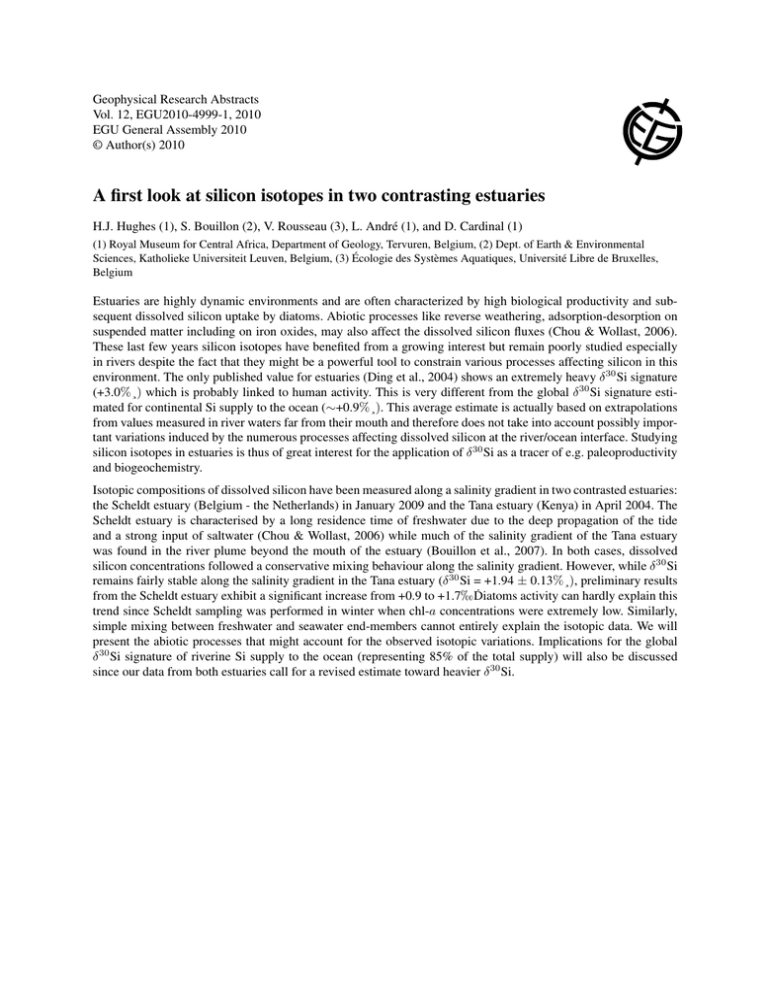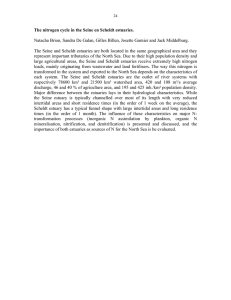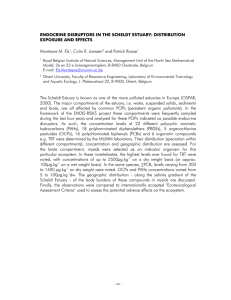A first look at silicon isotopes in two contrasting estuaries
advertisement

Geophysical Research Abstracts Vol. 12, EGU2010-4999-1, 2010 EGU General Assembly 2010 © Author(s) 2010 A first look at silicon isotopes in two contrasting estuaries H.J. Hughes (1), S. Bouillon (2), V. Rousseau (3), L. André (1), and D. Cardinal (1) (1) Royal Museum for Central Africa, Department of Geology, Tervuren, Belgium, (2) Dept. of Earth & Environmental Sciences, Katholieke Universiteit Leuven, Belgium, (3) Écologie des Systèmes Aquatiques, Université Libre de Bruxelles, Belgium Estuaries are highly dynamic environments and are often characterized by high biological productivity and subsequent dissolved silicon uptake by diatoms. Abiotic processes like reverse weathering, adsorption-desorption on suspended matter including on iron oxides, may also affect the dissolved silicon fluxes (Chou & Wollast, 2006). These last few years silicon isotopes have benefited from a growing interest but remain poorly studied especially in rivers despite the fact that they might be a powerful tool to constrain various processes affecting silicon in this environment. The only published value for estuaries (Ding et al., 2004) shows an extremely heavy δ 30 Si signature (+3.0%¸) which is probably linked to human activity. This is very different from the global δ 30 Si signature estimated for continental Si supply to the ocean (∼+0.9%¸). This average estimate is actually based on extrapolations from values measured in river waters far from their mouth and therefore does not take into account possibly important variations induced by the numerous processes affecting dissolved silicon at the river/ocean interface. Studying silicon isotopes in estuaries is thus of great interest for the application of δ 30 Si as a tracer of e.g. paleoproductivity and biogeochemistry. Isotopic compositions of dissolved silicon have been measured along a salinity gradient in two contrasted estuaries: the Scheldt estuary (Belgium - the Netherlands) in January 2009 and the Tana estuary (Kenya) in April 2004. The Scheldt estuary is characterised by a long residence time of freshwater due to the deep propagation of the tide and a strong input of saltwater (Chou & Wollast, 2006) while much of the salinity gradient of the Tana estuary was found in the river plume beyond the mouth of the estuary (Bouillon et al., 2007). In both cases, dissolved silicon concentrations followed a conservative mixing behaviour along the salinity gradient. However, while δ 30 Si remains fairly stable along the salinity gradient in the Tana estuary (δ 30 Si = +1.94 ± 0.13%¸), preliminary results from the Scheldt estuary exhibit a significant increase from +0.9 to +1.7hḊiatoms activity can hardly explain this trend since Scheldt sampling was performed in winter when chl-a concentrations were extremely low. Similarly, simple mixing between freshwater and seawater end-members cannot entirely explain the isotopic data. We will present the abiotic processes that might account for the observed isotopic variations. Implications for the global δ 30 Si signature of riverine Si supply to the ocean (representing 85% of the total supply) will also be discussed since our data from both estuaries call for a revised estimate toward heavier δ 30 Si.


